Those of you born in December, are triply blessed with birthstone choices, between tanzanite, zircon and turquoise. If blue is your favorite color, these three gemstones provide a wide variety of shade choices. If blue isn’t your color, you’re still able to choose from bright red, yellow, green, purple and brown gems. These very different gemstones also offer a wide range of jewelry possibilities. This blog provides information about tanzanite, while zircon and turquoise are covered in separate blogs.
Named for the country of Tanzania where it was discovered in 1967, tanzanite is the blue to violet variety of the mineral zoisite. This exotic gemstone can be found in only one place on earth, northern Tanzania’s Merelani hills which lie in the shadows of majestic Mount Kilimanjaro. With its lush blues and vibrant violets, tanzanite has become one of the most popular colored gemstones used in jewelry today.
At 100 East Fine Jewelry, we love making jewelry pieces using luscious tanzanite gemstones. You can see our current inventory by clicking the link for 100 East Fine Jewelry's Tanzanite Gemstone Jewelry collection. Some of our recent tanzanite designs include the following:
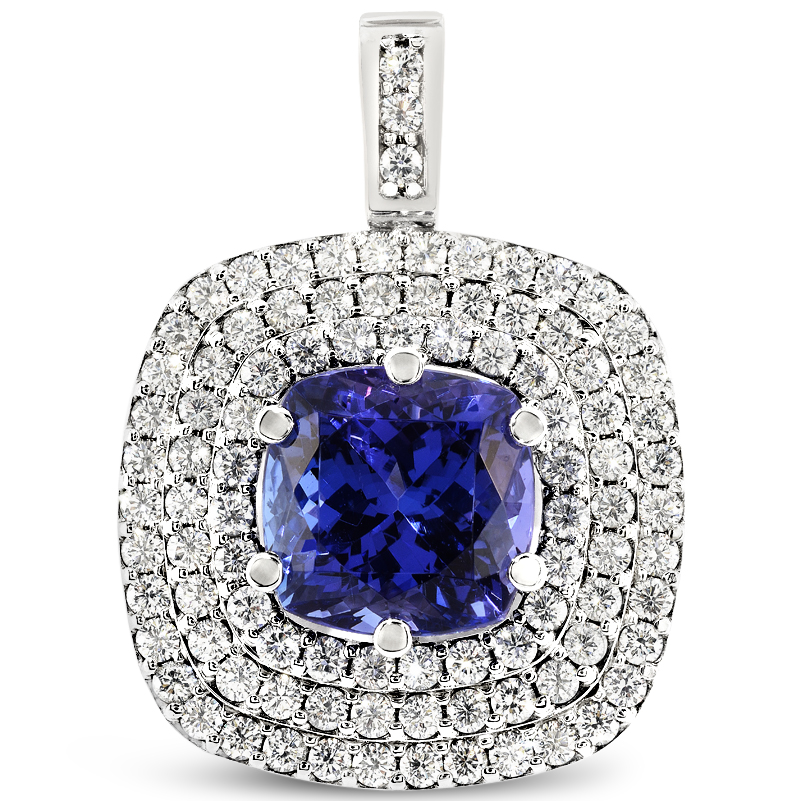
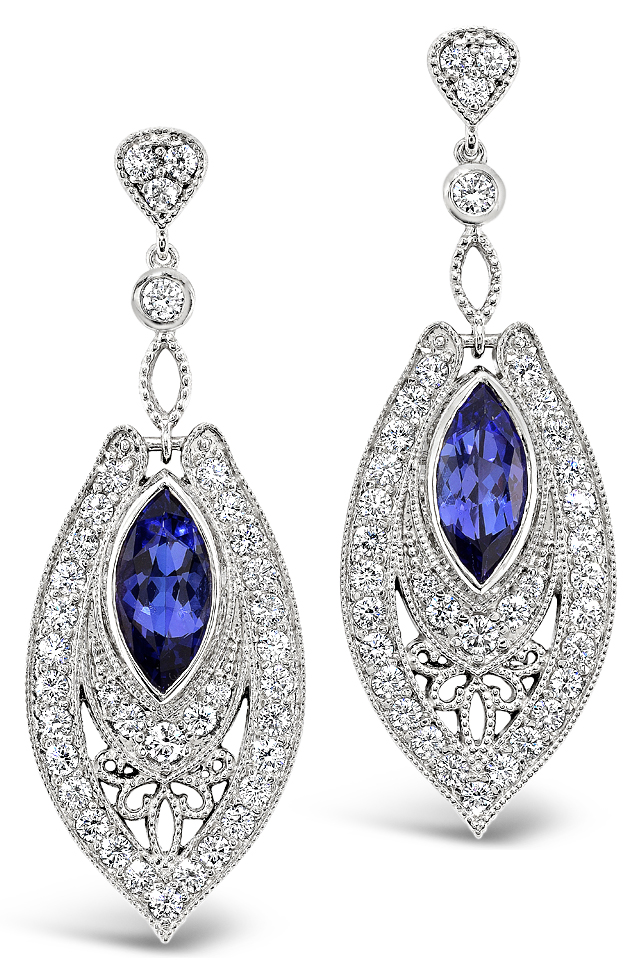
Gem quality transparent zoisite, can be found in other colors besides the blue to violet tanzanite variety. Specifically zoisite comes in pinks, yellows, greens and, rarely, oranges. While some of these other zoisite colors are mined in Tanzania (yellow, pink and green), they are also sourced from other countries. Pakistan, in particular, is known to source yellow and pink zoisite. Some disagreement has emerged among members of the gemstone trade on what to call these other zoisite hues.
Some dealers use the names pink, yellow or green tanzanite, while others prefer pink, yellow or green zoisite. The logic of those who use tanzanite do so because it’s a more recognized name and people will react better to a name they’re familiar with. On the other hand, dealers who prefer to call these varieties by their mineral name zoisite believe tanzanite is a source name for material that can only be mined in Tanzania. Therefore, the name is reserved strictly for material whose sole source is Tanzania. So, if you talk to one dealer who discusses pink tanzanite and another who refers to pink zoisite, they’re referring to the same product.
In addition to being a December birthstone, tanzanite is the recognized gift for the 24th wedding anniversary.
History and Lore
While the annals of most gemstones span millennia, Tanzanite’s story began a little more than half a century ago, in 1967. A local fortune hunter named Manuel d'Souza was being escorted by Masai tribesmen in a search for valuable gem crystals in Tanzania’s Merelani Hills which lie in the shadows of the snow-covered slopes of Mount Kilimanjaro.
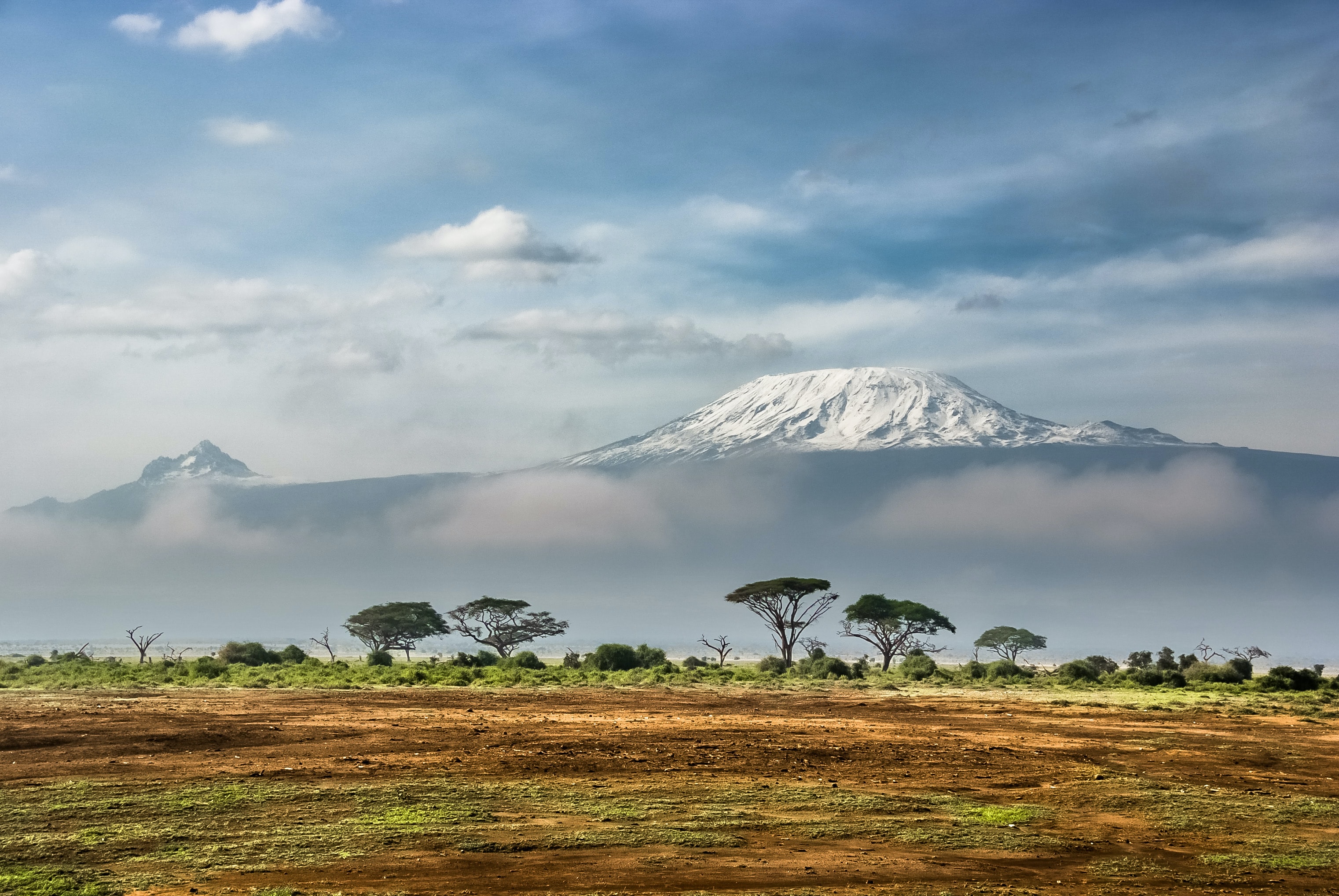
Photo by Sergey Pesterev on Unspalsh
While he and his Masai guides were traversing the barren land, they noticed highly transparent, intense violet-to-blue crystals on the ground.
At first, d'Souza thought the crystals were sapphires. But after checking the crystal’s hardness, he realized they were too soft to be sapphire. Further research led him to believe the crystals were olivine, so he filed claims to mine olivine in the location where he found the crystals. Doubts continued to surface that the crystals weren’t olivine. No one was quite sure what these beautiful crystals really were, but they didn’t want to miss out on the profits they were certain the material would generate. So, within a short time, 90 more claims appeared within a 20-square-mile area of the original discovery. D'Souza continued to pursue a definitive identification of the crystals with jewelers and gemologists he engaged. All were stumped. One of the gemologists was the son of a vice president of Saks Fifth Avenue in New York. While visiting his son in Tanzania, he was introduced to the unknown crystal and agreed to take it back to New York for additional evaluation. He had the crystals analyzed by a professional gem lab which identified the material as soizite. Around the same time, independently, both the British Museum and Harvard University also confirmed the previously unknown crystals as “blue zoisite.”
D’Souza modifed his claim to change the name of the mineral. Saks, meanwhile, decided developing a business around this new gemstone was too big an undertaking. The “blue zoisite” was taken to Tiffany & Company, who loved the new gemstone and believed it could become an international phenomenon. Tiffany made an exclusive deal to distribute the gem. Tiffany’s management, however, was concerned about using the mineral name, zoisite, believing women wouldn’t buy it because it sounded too much like “suicide”. Tiffany renamed the gem after the country where it was discovered and in 1968 mounted a huge publicity campaign. Named and promoted by Tiffany, tanzanite rapidly became a sensation, winning the public’s heart. It became a popular choice with leading gem professionals, jewelry designers and customers with an eye for beautiful and unusual gems. Its vivid colors, high clarity and potential for large cut stones quickly established tanzanite as one of the premier gemstones in the world.
Since its discovery in 1967, tanzanite production has been inconsistent. Political instability within Tanzania along with catastrophic flooding of the mines in 1998 caused alternating periods of oversupply followed by supply shortages accompanied by dramatic price fluctuations. The mine was acquired and upgraded in 2003 followed by the acquisition in 2004 by its current owners who stabilized the tanzanite value chain.
Use in Jewelry Today
With its dazzling array of blue to violet hues and variety of shapes, tanzanite is a fascinating gemstone, which suits any personality. It has become very popular not only for its attractive blue and violet colors, but also for its strong pleochroism. (Pleochroism is the ability of a gemstone to show different colors when viewed in different crystal directions.) Although in its finest qualities, tanzanite can exhibit a blue color comparable to sapphire, it cannot compare to sapphire in durability.
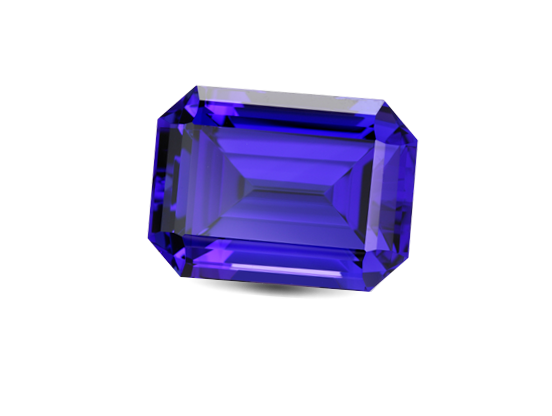
Photo Courtesy of GIA
Tanzanite’s popularity has only grown since its recent discovery, especially among those in the fine jewelry, art and fashion worlds. From established jewelers to trendy artists, tanzanite is a very exciting choice. The market for tanzanite jewelry worldwide continues to rapidly expand, allowing jewelers to offer almost a limitless variety of options to their customers.
Tanzanite is a versatile gemstone that comes in a wide variety of sizes, shapes, and facet designs. While cushion cuts are commonly used for larger tanzanite pieces, oval mixed cuts, fantasy cuts, trillions, octagons and round cuts are also popular. The finest and deepest colors are usually seen in sizes over 5 carats. Smaller stones are often less intense in color. Two distinct markets have developed for tanzanite; one for large, fine gems and the other for small calibrated gemstones.
Tanzanite is resistant to the effects of normal heat, light and common chemicals. It does have limitations, though. It’s not a particularly hard gemstone, has one direction of cleavage and is subject to thermal shock. It is best set in earrings, pendants and necklaces. While not recommended for daily wear in a ring, with a protective mounting and some care it can be an attractive special-occasion ring. I did have an instructor at GIA who had a tanzanite engagement ring for years, but obviously knew and accepted the stone’s limitations.
Eye-visible inclusions
decrease tanzanite’s value, particularly in lighter colored stones. As with
most gemstones, any inclusions that might pose
durability problems, such as fractures, greatly lowers tanzanite’s value. Fine
tanzanite is typically free of inclusions.
Like pearl or opal, tanzanite is a gemstone that
requires special care. With its
relatively low hardness, tanzanite can be scratched if brought into contact
with other gemstones. Ultrasonic and steam cleaners are
never recommended for tanzanite. We believe all your gemstone jewelry is best
cleaned with warm, soapy water and a soft brush. We consider this a single,
safe method to use for cleaning all gemstone jewelry. For additional details,
please read our blog; Cleaning Fine Gemstone Jewelry. To learn
about caring for all your fine jewelry, please read our blog; Caring for Fine Gemstone Jewelry.
Color Characteristics and Treatments
Tanzanite’s range of colors, from pure rich blue to violet, is fairly narrow; narrower even than sapphire. Like many other colored gemstones, vivid, strongly colored tanzanite is considered the most valuable. Generally speaking, the deeper blue a Tanzanite gemstone, the more value it carries. The most sought after and prized tanzanites are strongly saturated pure blue, like sapphire, or intense violetish blue. An intense violetish blue hue enhanced by red flashes of pleochroic color from within the stone is considered exceptional. Fine tanzanite gemstones are often described as “velvety,” mostly because of their deep, saturated color. Lighter toned pastel hues are more plentiful and affordable than vivid colors, with a subtle appeal of their own.
While natural blue to violet colored tanzanite can be found, normally it’s a gray or brown color coming out of the ground. The majority of tanzanite is heat treated to obtain the highly desirable colors tanzanite is famous for.
The face-up color of a finished tanzanite gemstone is influenced by two factors; its pleochroism and decisions made by the gemstone cutter on the stone’s orientation.
- Many gemstones show two pleochroic colors, but tanzanite show three. Tilt a tanzanite gemstone and you’ll see three distinct colors in three crystal directions. Making it more interesting, tanzanite can show two variations of its three pleochroic colors. One set is purplish red, deep blue, and yellow green. Alternatively, they can be deep blue, violet and colorless. The gem’s strong pleochroism results in fashioned gemstones with a mix of both blue and violet colors in a wide range of tones.
- A cutter’s choice of orienting tanzanite’s pleochroic colors determines the gem’s overall face-up color. Cutters have to consider certain financial realities when deciding how to cut tanzanite. Cutters can fashion gems with a range of color from violetish blue to bluish violet depending on the amount of weight they want to retain from the rough. Cutting a tanzanite to emphasize the violet color usually wastes less rough than cutting it to get a violetish blue color. That's part of the reason face-up violet-purple tanzanites are more plentiful than specimens with a stronger blue color component. But this decision must be balanced against the higher per-carat price that the finer violetish blue color might bring. The cutter essentially makes a choice between a smaller top-color gem and a larger less costly one.
As mentioned above, tanzanite
is commonly heat treated to create its blue to violet color. Trade
professionals assume the majority of the tanzanite on the market has been
heated in some way. The resulting color treatment is permanent, with no
additional durability concerns.
Other treatments which might be performed on
tanzanite are coating and fracture filling. Both treatments are rarely used, though. Some light-colored
tanzanite has been known to be coated to improve
the intensity of the blue-violet color. The objective is to pass them off
as better-quality, more valuable material. Tanzanite, like any transparent gem
can have surface-reaching factures. Occasionally, those fracture can be filled
with glass or resin materials. Neither of these treatments are considered
permanent and require special care.
There has been no successful synthetic production of tanzanite.
Formation, Mining and Cutting
Tanzanite is rarer than diamond and comes from one place in the world. Mined from the Merelani Hills at the base of Mount Kilimanjaro, tanzanite deposits lie within a slender five mile wide strip of ground with grass-covered hillsides, scrub brush, rocky soil and an occasional tree. In the major mechanized operations there, thousands of workers recover tanzanite from mines over a 100 meters (more than 300 feet) deep.
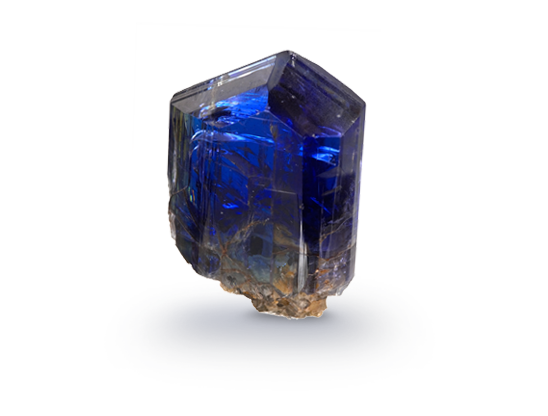
Photo Courtesy of GIA
Because of its pleochroism and cleavage, tanzanite requires experienced lapidaries who are able to maximize both the stone’s size and unique color. Fortunately, tanzanite is a plentiful stone, allowing cutters room for creativity.
Famous Tanzanite Jewelry
Queen of Kilimanjaro Tiara - Weighing in at 242 carats, this tiara features one of the largest faceted tanzanite gemstones. The tiara resembles a hooded king cobra, with the famous tanzanite sitting at its center. In addition to the mammoth tanzanite, the tiara holds 803 tsavorite garnets and 913 diamonds. It’s part of a major gemstone collection belonging to Michael Scott, who served as Apple’s first CEO from 1977 to 1981.
Chopard’s “Belle” Necklace with 69 Carat Tanzanite Center - This intricate filigreed lace collar necklace was created by the Swiss design house, Chopard. A variety of shades of blue and pink sapphire form the collar of the necklace, which come together to feature the 69 carat pear-shaped tanzanite. The necklace was designed for Disney’s Belle, from “Beauty and the Beast”.
Credit: Gemological Institute of America (GIA), American Gem Trade Association (AGTA), Stuller Inc and Gemworld International

